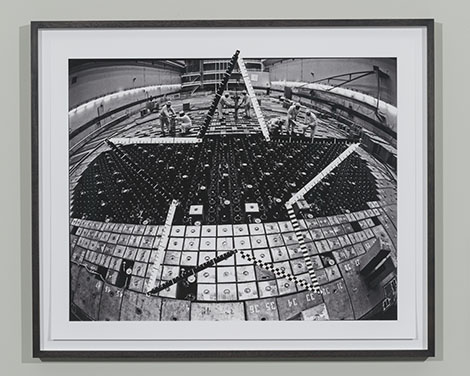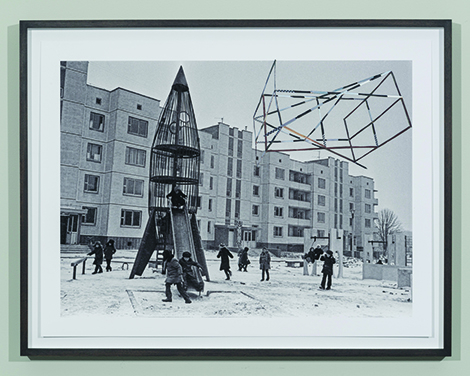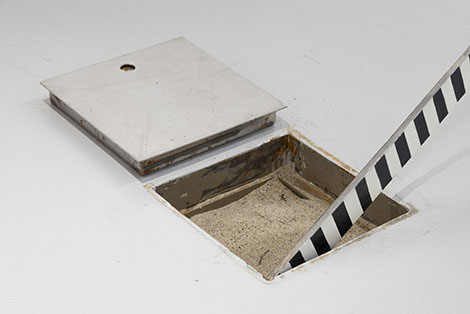Can the aftermath of a nuclear disaster or any other kind be measured or quantified? Certainly not with a handmade yard-stick. British twins Jane and Louise Wilson ponder these questions in their compelling exhibition “Imperial Measure.”
The installation of architectural interventions within the gallery parallel the Wilsons’ additions to appropriated archival and contemporary black and white photographs of Pripyat, a Ukrainian city built to house the workers at the Chernobyl nuclear power station. Pripyat, or Atomgrad as it was previously known, was evacuated after the explosion. While now open to occasional visitation, study and tourism, the city remains uninhabitable. The Wilsons traveled to Pripyat in 2010, where they made images of dilapidated and abandoned public buildings that included communal spaces like swimming pools and classrooms forever devoid of people.

Jane and Louise Wilson, Imperial Measure #1 (Pripyat, Ukraine), 2014. Photo: Courtesy of Josh White.
The Wilsons’ black-and-white images differ from those made by photographers like Robert Polidori and Gerd Ludwig who objectively documented the lush color of the ruins and the natural growth that has begun to emerge since the catastrophe three decades ago. The Wilsons are not interested in aestheticizing the environment around the nuclear disaster, however, but rather use it as a site to explore cultural, architectural and political ideologies. The relics of Chernobyl and Russian symbology are metaphors for loss—the loss of life as well as loss of communal values and place.
Archival pre-evacuation photographs include propagandistic images of workers as well as children, who the Wilsons have often obscured with measuring devices. Each photograph is overlaid with a cutout of a foldable wooden yardstick with black-and-white markings. These collaged elements bisect the compositions as lines, stars or Constructivist sculptures. In Imperial Measure #1 (Pripyat, Ukraine) (2014), the outline of a five-pointed Soviet star covers a dilapidated swimming pool. This iconic symbol of power is diffused when superimposed over an image of ruins. In Imperial Measure 16 (Atomgrad, Ukraine) (2014) the Wilsons begin with a pre-evacuation image depicting children playing on a jungle gym shaped like a rocket ship in front of a 1970s soviet bloc apartment building. Through the addition of a collaged cutout resembling a Constructivist sculpture that hovers above the image like an alien spaceship, the Wilsons call attention to a trajectory from Russian Constructivism to Chernobyl to the fall of the USSR as examples of a chain reaction of failed utopias.
Blind Landing Lab (Lab 1) (2012), a cast aluminum and enamel plated sculpture, cuts across the gallery space spanning a diagonal from a small chamber of sand beneath the floor to the ceiling and paralleling the measuring devices within the photographs. The point here is not to calculate the distance but to acknowledge the disruptive nature and futility of any attempt at measurement. That the Wilsons also include a photograph of the impaired San Onofre nuclear plant surrounded by yardsticks reaching into the sky speaks to the universality of their project. This image resonates for Californians who would be similarly affected by immeasurable radiation that would emanate from the plant, should it explode.



